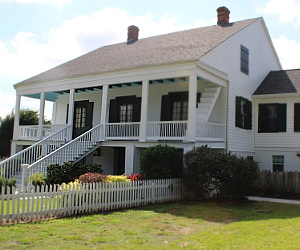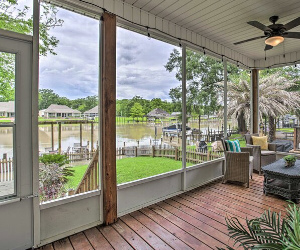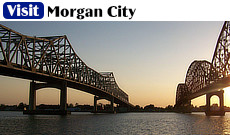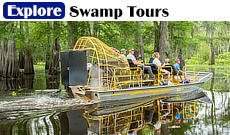
Acadiana and Cajun Country Travel Guide
The Acadiana Region
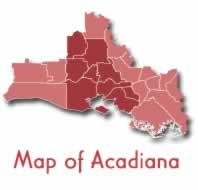 Map showing location of the Acadiana Region (courtesy of the Acadiana Legislative Delegation of the Louisiana Legislature) |
Acadiana is a vast region emcompassing 22 parishes in French Louisiana in the southern part of the state. It stretches from the Gulf of Mexico to about 100 miles inland, and covers about 14,500 square miles.
The Acadiana geography consists low gentle hills to the north, prairies, and marshes, swamps and bayous closer to the Gulf coast. Rice, sugar cane, and soybeans are the dominant agricultural crops.
The Parishes and Cities of Acadiana
Acadiana is the name given to the traditional twenty-two parish Cajun homeland, which in 1971 the Louisiana state legislature officially recognized for its unique Cajun and Acadian heritage (per House of Representatives Concurrent Resolution No. 496). It stretches from just west of New Orleans to the Texas border along the Gulf of Mexico coast, and about 100 miles inland to Marksville.
This includes the following 22 parishes: Acadia, Ascension, Assumption, Avoyelles, Calcasieu, Cameron, Evangeline, Iberia, Iberville, Jefferson Davis, Lafayette, Lafourche, Pointe Coupee, St. Charles, St. James, St. John The Baptist, St. Landry, St. Martin, St. Mary, Terrebonne, Vermilion, and West Baton Rouge. The cities of Baton Rouge and New Orleans are NOT considered a part of Acadiana. Read more about the Acadiana Legislative Delegation and the location of Acadiana
The name "Acadiana" often is applied only to Lafayette Parish and several neighboring parishes, usually Acadia, Iberia, St. Landry, St. Martin, and Vermilion parishes, and sometimes also Evangeline and St. Mary; this eight-parish area, however, is actually the "Cajun Heartland, USA" district, which makes up only about a third of the entire Acadiana region.
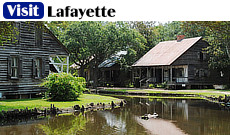 |
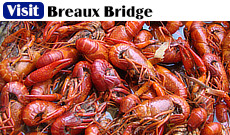 |
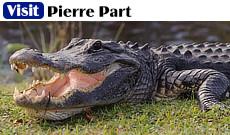 |
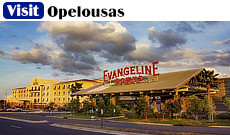 |
 |
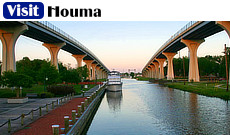 |
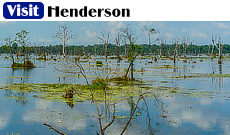 |
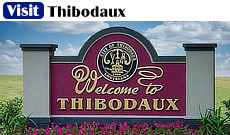 |
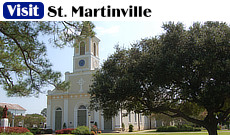 |
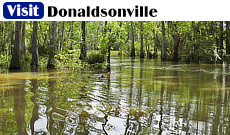 |
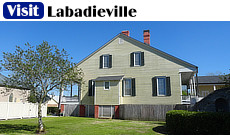 |
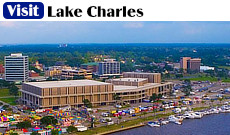 |
The Cajuns
The residents in the area are descended from various native American and nationalities, but many are "Cajuns", descendants of 18th-century Acadian exiles from what are now Canada's Maritime Provinces.
While Cajuns have a large presence, not all who live in Acadiana is culturally Acadian or speaks Cajun French, nor is everybody who is culturally Acadian or "Cajun" descended from the Acadian refugees.
The population of Acadiana is about 1.4 million residents. There are dozens of large cities, and small communities, in Acadiana. Listed below are a sampling of popular Louisiana cities in Acadiana.
Cajun Country Video ... from Louisiana Travel
 |
 |
Lafayette is located in the heart of Cajun Country and Acadiana, on the banks of the Vermilion River, and at the junction of Interstate Highway I-10 and I-49. Lafayette is known for its Cajun and Creole culture, and its legendary Cajun cooking.
Dining establishments featuring outstanding cuisine are widely known in Acadiana and nationwide, such as Prejean's Restaurant, Randol's Restaurant, Blue Dog Cafe, Don's Seafood Restaurant, and Poupart's Bakery.
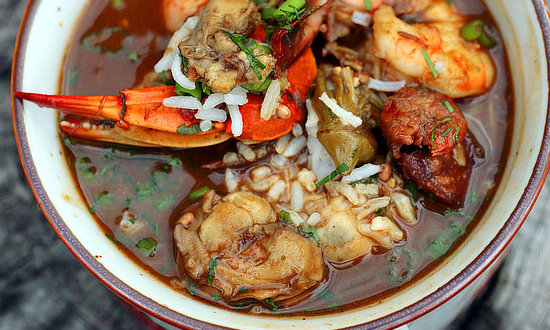 Lafayette crawfish make a perfect addition to Louisiana seafood gumbo, along with shrimp, crab, okra and rice |
Lafayette serves a large, regional retail and tourism industry. Its economy today is diverse, including large onshore and offshore drilling, production and support services for the oil and gas industry. Lafayette is also the home of the University of Louisiana and its Ragin' Cajuns sports program. We know the famous streets of Lafayette well, including Evangeline Thruway, Kaliste Saloom, Congress Street, Ambassador Caffery Boulevard, and Johnston Street downtown.
Lafayette's first settlers were French Acadians ("Cajuns") who came to the area in the 1700s. Originally founded in 1821 as Vermilionville, the settlement was renamed Lafayette in 1884. Today a popular tourist attraction called "Vermilionville" recreates the Cajun lifestyle and folklore in a series of restored buildings.
The Acadian Cultural Center is operated by the National Park Service (NPS). The center provides permanent and special exhibits, an award-winning film, ranger talks, and programs that share the history, customs, language, and contemporary culture of the Acadians who became Louisiana's Cajuns.
Located at 200 Greenleaf Drive in Lafayette, Acadian Village features a number of restored area homes, a blacksmith shop, general store and chapel. It also serves as an event center for special event
The parish seat of Lafayette Parish, the City of Lafayette is located near St. Martinville, Abbeville, Breaux Bridge, Henderson, Scott, Crowley, Rayne and Kaplan.
Lafayette HotelsCompare prices, make reservations and read what travelers say about hotels in Lafayette
Vacation Home Rentals in LafayettePlanning a trip to Lafayette or Acadiana and need a vacation rental?
|
Cajun Music from Lafayette resident Cedric Watson: A Mini-Documentary from Louisiana Travel
 |
Lake Charles, the 5th largest city in Louisiana, is known for its Cajun and Creole culture, and its legendary Cajun cooking and fine cuisine. Lake Charles is considered the "Festival Capital" of Louisiana with its 75 annual festivals, from Mardi Gras early each year to the Contraband Days Pirate Festival later in the year.
Area gaming casinos include the L'Auberge Du Lac Casino Resort and the Isle of Capri Casino and Hotel. In addition, nearby is the Delta Downs Racetrack, Casino and Hotel. A large petrochemical industry base also provides a part of the area economy.
The first people to settle the lake were Mr. and Mrs. LeBleu of Bordeaux, France. They arrived in 1781 and built their home six miles east of the present site of Lake Charles, and known today as LeBleu Settlement. On March 16, 1867 the area formerly known as Charleston was incorporated into the town of Lake Charles.
Rich in history, the Charpentier Historic District extends over 40 blocks of downtown Lake Charles, and includes one of the finest collections of Victorian architecture in Louisiana, dating from the late 1800s and early 1900s.
 |
Houma, "The Heart of America's Wetland", is located on historic U.S. Highway 90 between New Orleans and Morgan City. It is also sometimes called "the Venice of America" due to the numerous bayous and bays in the immediate area, and its strategic location on the Intracoastal Waterway and the Houma Navigation Channel.
It is the parish seat of Terrebonne Parish, and has a population of about 35,000 residents.
 |
Houma was founded in 1834 and incorporated in 1848, and is named after the Houmas Indians. Terrebonne Parish was established March 22, 1822. Houma and these surrounding communities are heavily based on Cajun tradition and culture, and are proud of their open hospitality and friendliness.
Houma is famous for its Cajun food, charter boat fishing, swamps, Cajun music and dance halls. Houma also is well known for its birding trails, an exotic wildlife park, museums, Mardi Gras celebrations and more. It is also close to the Atchafalaya Basin and available are a variety of marsh tours, swamp tours and airboat tours.
Not far from Houma is Lake Verret and Pierre Part, the location of some episodes of the popular TV reality show "Swamp People". Other segments are shot around other swamps in South Louisiana, such as those near Bayou Sorrel, Bayou Pigeon, Morgan City and and other locales.
Houma's geographical location produces a combination of deep sea, coastal, brackish and freshwater fishing. Its location close to Terrebonne Bay, Timbalier Bay and the open expanses of the Gulf of Mexico offers plentiful fishing options including king mackerel, cobia, redfish, speckled trout, bass and drum.
 |
 |
In the heart of Cajun Country, Thibodaux is located in south Louisiana on Louisiana Highway LA-1 on the banks of historic Bayou Lafourche. Our family roots are from nearby Paincourtville, Napoleonville, Plattenville and Labadieville, where my grandfather worked in the sugar cane fields along Bayou Lafourche.
It is the parish seat of Lafourche Parish and has a population of about 15,000 residents. It was incorporated as a town in 1838.
Area communities include Labadieville, Paincourtville, Plattenville, Raceland, Morgan City, Lockport, Des Allemands, Chauvin, Houma, Pierre Part, and Napoleonville.
Nicholls State University is located in Thibodaux.
 |
Bienvenu! In the heart of Cajun Country, just east of Lafayette on I-10, is the community of Breaux Bridge, the Crawfish Capital of the World, close to Henderson, the gateway to the great Atchafalaya Swamp.
Breaux Bridge is known for its Cajun and Creole culture, and its legendary Cajun cooking and crawfish. Excellent Cajun cooking abounds in Breaux Bridge, whether your tastes tend to Seafood Gumbo, Crawfish Etouffee, Crawfish Bisque, Crawfish Pie, Fried Crawfish, Boudin or maybe even Fried Alligator! Here are located a number of popular restaurants such as Mulate's Cajun Restaurant on Mills Avenue.
Breaux Bridge, located on historic Bayou Teche, is also the site of the world famous Crawfish Festival.
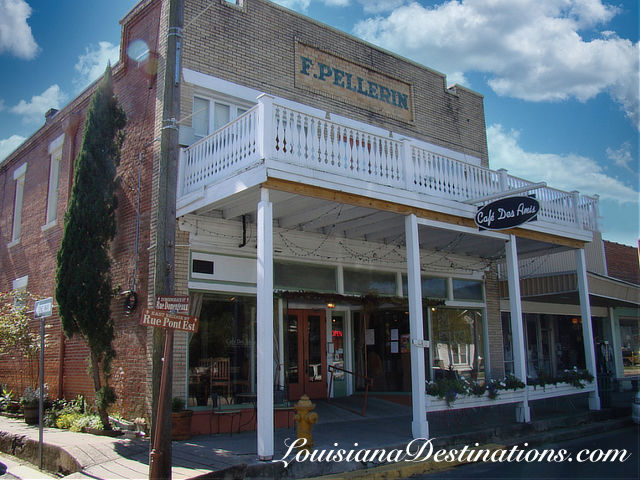 Scene in downtown Breaux Bridge, Louisiana |
In 1771, Acadian pioneer Firmin Breaux bought land in the present-day city of Breaux Bridge, and in 1799 built a suspension footbridge across the Bayou Teche to help ease the passage for family and neighbors. Area residents and visitors soon knew of the bridge, and began calling it “Breaux’s bridge”, later adopted as the city's name. The town received its official founding in 1829 when Scholastique Picou Breaux drew up a plan called Plan de la Ville Du Pont des Breaux.
The Catholic church parish was created in 1847 and Breaux Bridge was officially incorporated in 1859. In 2009 Breaux Bridge celebrated its 150th birthday. In 1959, the Louisiana legislature designated Breaux Bridge as "the Crawfish Capital of the World".
Donaldsonville
Donaldsonville is located in south Louisiana at the juncture of the Mississippi River and Bayou Lafourche. Situated on highway LA-1, Donaldsonville is about a one hour drive from either Baton Rouge or New Orleans.
The Sunshine Bridge provides access to the East Bank of the Mississippi River. It is the parish seat of Ascension Parish, and has a population of about 8,000 residents. Area communities include Labadieville, Paincourtville, Thibodaux, Plattenville, White Castle, and Napoleonville.
Pierre Part
Pierre Part is a community of about 3,500 residents in south central Louisiana, with the largest nearby cities being Baton Rouge, Donaldsonville, and Thibodaux.
It is situated on land only 3 feet above mean sea level and is surrounded by water, and was thus isolated from much of the world, and was not accessible by land, until the mid-20th century.
Today, Louisiana Highway 70 runs through Pierre Part, and the town can be reached from Morgan City from the south and Paincourtville from the east, as well as Donaldsonville and White Castle.
Pierre Part is just east of the Atchafalaya Floodway system levee, and just north of Lake Verret, a relatively shallow lake surrounded by beautiful cypress trees.
The Atchafalaya River meanders from near Simmesport southward to Morgan City and the Gulf of Mexico. The Atchafalaya Basin is a unique combination of wetlands, bayous, marshes, estuaries,and river delta area. It is often called "America's Wetland", and covers an area 20 miles wide and 150 miles long.
Swamp People debuted in August 22 of 2010, and has become a runaway hit ever since, with multiple seasons since.The History Channel has announced that Season 14 of Swamp People will debut on January 5, 2023, at 8/7C.
The show follows a group of alligator hunters during the 60-day Louisiana alligator season in various areas of South Louisiana, including the huge Atchafalaya Swamp. Various segments are shot around South Louisiana, such as Pierre Part and Pecan Island bordering the bayous, the great Atchafalaya Swamp, and the Gulf of Mexico.
Eunice
 |
Eunice is located in St. Landry Parish along U.S. Highway 190, with Opelousas to the east, and Kinder to the west. The City of Mamou lies to the north along Louisiana Highway 13, and to the south is Crowley. Located in deep inside Cajun Country, Eunice is known as "Louisiana's Prairie Cajun Capital". Eunice is a lively city that actively celebrates its history and Cajun culture.
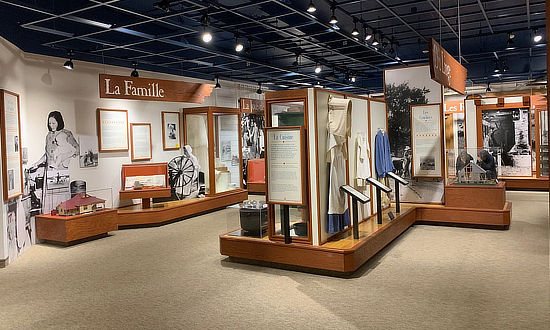 Exhibit area at the Prairie Acadian Cultural Center in Eunice |
While the town is well known for producing some renown musicians, Eunice is most popular for its spectacular Mardi Gras celebration, called the Courir de Mardi Gras. This event showcases some of the most unique cultural customs and the best sampling of live music and Cajun cuisine. It is also home to the famous the World Championship Crawfish Étouffée Cook-Off.
The Jean Lafitte Prairie Acadian Cultural Center is operated by the National Park Service (NPS). The Acadian exiles from Canada's Nova Scotia who settled Louisiana's prairies developed a distinctive cultural mix of Cajun, Creole, and cowboy. The Prairie Acadian Cultural Center tells this story through ranger programs, exhibits, and films. The center features cooking and crafts demonstrations, local musicians, and dancing for all. Center admission is free, and it is located at 250 Park Avenue in Eunice.
The Cajun French Music Hall of Fame and Museum is located at 240 South C.C. Duson Street. It is dedicated to promote and preserve Cajun music and culture. Phone 337.457.6534 for hours and information.
Jennings
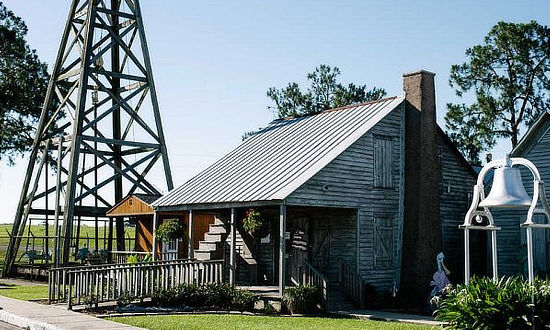 The Louisiana Oil and Gas Park in Jennings |
Jennings, the "Cradle of Louisiana Oil", is located on Interstate Highway I-10 and historic U.S. Highway 90, about midway between the cities of Lafayette and Lake Charles. Agriculture is also an important part of the area economy, led by rice and soybeans. The rice fields are also used for crawfish farming, a source of that Cajun delicacy available in many Jennings and Acadiana restaurants in the form of Crawfish Gumbo, Crawfish Etouffee, Crawfish Bisque, Crawfish Pie and Fried Crawfish, and more!
During our most recent visit to Jennings, we enjoyed the Louisiana Oil and Gas Park. Other attractions include the W.H. Tupper Museum, the Zigler Art Museum, the Louisiana Telephone Pioneer Museum, and many other worthwhile things to do. Nearby towns include Lacassine, Welsh, Duson, Crowley, Lake Arthur, Rayne, Mermentau, and Gueydan.
Jennings is the parish seat of Jefferson Davis Parish and has a population of about 10,000 residents. Oil history in Louisiana began on September 21, 1901, when the state’s first oil well, located in the Jennings Field, was brought in. Today the oil and gas industry remains a key element in the economic development of the area.
 |
Morgan City is known worldwide for fresh and salt water fishing, hunting and fine Cajun cuisine. It is the gateway to the Gulf of Mexico for the shrimping and oilfield industries. Its economy is diverse, including large onshore and offshore drilling, production and support services for the oil and gas industry.
Situated in St. Martin Parish and St. Mary Parish, the City of Morgan City is at an elevation only 7' above sea level. Morgan City is located on U.S. 90 about half-way between New Orleans and Lafayette.
We've visited Morgan City since the early 1960s, and remember attending the Shrimp and Petroleum Festival, and the blessing of the shrimp boat fleet. Morgan City is located on the banks of the Atchafalaya River and near the Gulf of Mexico, near the southern end of the great Atchafalaya Swamp.
Morgan City was originally named Tiger Island, and later renamed Brashear City in honor of Dr. Walter Brashear who had purchased large amounts of land holdings in the area. Incorporated in 1860 as Brashear City, the community's name was changed in 1876 to Morgan City after Charles Morgan, the man who dredged the Atchafalaya Bay to accommodate ocean-going vessels.
 |
 |
The City of New Iberia is located on U.S. Highway 90 between New Orleans and Lafayette on the banks of the historic Bayou Teche. Area attractions include the beautiful Shadows on the Teche home and Jungle Gardens. Nearby Avery Island is home of the world-famous Tabasco Sauce and the oldest salt mine in North America.
New Iberia is also home to the Louisiana Sugar Cane Festival each September. It is the parish seat of Iberia Parish, and was founded in 1779 and incorporated in 1839.
On nearby Jefferson Island is the Joseph Jefferson Mansion, built in 1870 and listed on the National Register of Historic Places This charming twenty-two room Southern mansion, with a fourth-story cupola, is part of the popular Rip Van Winkle Gardens.
 |
Opelousas, Louisiana's 3rd oldest city, was founded in 1720 and was a trading post between New Orleans and Natchitoches in the 1700s and 1800s. Settled by French Creoles and Acadians, Opelousas is known for its Zydeco music.
The parish seat of St. Landry Parish, Opelousas is located just north of Lafayette, and near Sunset, Grand Coteau, Eunice, Port Barre, LeBeau, and Ville Platte.
 |
It is located about 50 miles south of Alexandria via I-49; a major east-west highway through Opelousas is U.S. Highway 190.
Nearby is the well known Evangeline Downs Horse Race Track and Creole Heritage Folklife Center. Cajun cooking is popular in Opelousas, and ingredients such as Boudin, Tasso, crawfish are common. Opelousas is also known as the Spice Capital of Louisiana, and is the home of nationally known and respected companies such as Tony Chachere's, Savoie's Cajun Meats, and LouAna Cooking Oil.
Ville Platte
Ville Platte is the parish seat of Evangeline Parish, and has a population of about 8,500. Ville Platte (meaning "flat town" in French) has a large number of Cajun and Creole families and descendants.
Well known 6,400 acre Chicot State Park is only about 10 miles to the north. Nearby towns include Forest Hill, Glenmora, Oberlin, Oakdale, Eunice, Mamou, Opelousas, Bunkie, and Turkey Creek.
The earliest record of settlement in the immediate area of Ville Platte was in the 1780s. The first post office in Ville Platte was established in 1842.
 |
 |
St. Martinville is located in extreme south Louisiana, in the heart of Cajun Country, and situated roughly between New Iberia and Lafayette. It is the parish seat of St. Martin Parish and has a population of about 7,000 residents. It is located on the banks of the historic Bayou Teche, and the home of Longfellow-Evangeline State Historic Site. In St. Martinville is the Evangeline Oak made famous in Longfellow's poem.
St. Martinville is also the home to the Acadian Memorial which honors the 3,000 Acadian men, women and children who found refuge in Louisiana after British forces exiled them from Acadie.
Henry Wadsworth Longfellow's 1847 epic poem Evangeline made people around the world more aware of the 1755 expulsion of the Acadians from Nova Scotia and their subsequent arrival in Louisiana. Before Europeans and Africans settled along Bayou Teche in present-day St. Martinville, Native Americans had long hunted in this area, including the Attakapas and the Chitimacha. Long before roads, Bayou Teche was a 100 mile long highway, and later was an important factor in the development of St. Martinville. In the mid-1750s, Louisiana's French rulers made land available in the Attakapas District for the raising of cattle to supply meat for New Orleans.
St. Martinville is also the home to the Acadian Memorial, and the historic St. Martin de Tours Catholic Church. The St. Martinville Historic District is on the National Register of Historic Places.
Cypremont Point State Park, located to the south of St. Martinville, is a favorite spot for birding enthusiasts and eco-tourists. This 185-acre park offers access to the Gulf of Mexico, along with a man-made beach, fishing, sailing, windsurfing, and other water sports.
Crowley
Crowley is located in South Louisiana, and has a population of about 12,000 residents. It is the Parish Seat of Acadia Parish. Thanks to the warm climate and long growing season, rice farmers in the area usually harvest twice a year. Rice continues to play an important role in Crowley’s economy. Crawfish farming is also a mainstay of the local economy.
The Annual Gumbo Cook-Off is held at the Enterprise Center Grounds in Crowley, and the city hosts the well-known International Rice Festival.
Crowley recently restored the Ford Building, built in 1921 as a car dealership and partial assembly line for Ford Model Ts. The building, open for tours, now serves as the Crowley City Hall and houses four museums. It is also the site of the popular Cadien Toujours Boucherie.
Kelly's Landing is a agricultural museum and working Cajun Prairie farm. It is conveniently located 10 minutes north of the beautiful and historic city of Crowley, at 1109 Roberts Cove Road. Phone 337.263.5520
Swamp Tours in the Acadiana Area
One of the most popular things to do in Louisiana is touring the swamps! Most tours are concentrated in South Louisiana.
The area between Lafayette and Baton Rouge offers a number of swamp tours, operating from communities such as Breaux Bridge, Henderson, St. Martinvile and Plaquemine.
Learn more about Swamp Tours in the Atchafalaya Basin.
